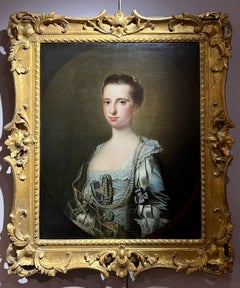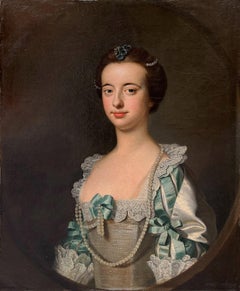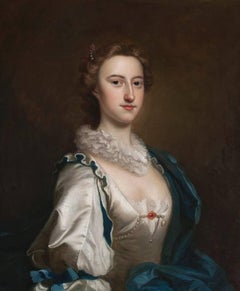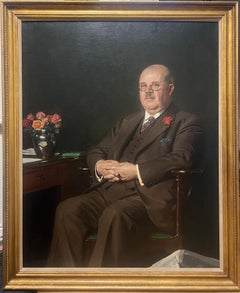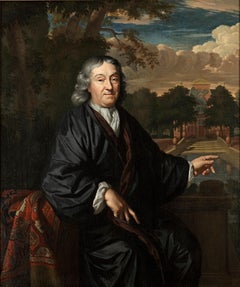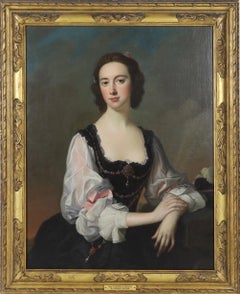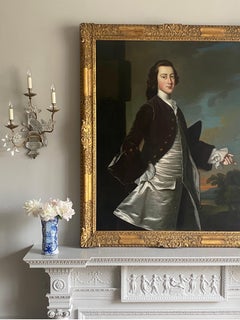Thomas Hudson Paintings
British, 1701-1779
Thomas Hudson (1701–1779) was an English painter, almost exclusively of portraits. Hudson was born in Devonshire in 1701.
His exact birthplace is unknown. He studied under Jonathan Richardson in London and, against the latter's wishes, married Richardson's daughter at some point before 1725.
Hudson was most prolific between 1740 and 1760 and, from 1745 until 1755 was the most successful London portraitist. He had many assistants, and employed the specialist drapery painter Joseph Van Aken.
Joshua Reynolds, Joseph Wright and the drapery painter Peter Toms were his students.
Hudson visited the Low Countries in 1748 and Italy in 1752.
In 1753 he bought a house at Cross Deep, Twickenham, just upstream from Pope's Villa.
He retired toward the end of the 1750s. William Hickey described the elderly Hudson, "His figure was rather grotesque, being uncommonly low in stature, with a prodigious belly, and constantly wearing a large white bushy periwig. He was remarkably good tempered, and one of my first-rate favourites, notwithstanding that he often told me I should certainly be hanged.".
He died at Twickenham in 1779. His extensive private art collection was sold off in three separate sales.
Many of Hudson's works may be seen in art galleries throughout the United Kingdom. They include the National Portrait Gallery, the National Maritime Museum, Tate, Barnstaple Guildhall, Foundling Museum and the Bristol City Museum and Art Gallery.to
3
Overall Width
to
Overall Height
to
3
3
1
2
1
1
1
1
3
3
3
3
3
781
717
711
694
2
3
Artist: Thomas Hudson
Portrait of Lady Mansfield of Ringwood
By Thomas Hudson
Located in London, GB
Portrait of Lady Mansfield of Ringwood
Oil on Canvas, unsigned
Image size: 25 x 30 inches (63 x 76 cm)
Original carved & gilded frame
Provenance
Descended through the Family Estate
...
Category
18th Century English School Thomas Hudson Paintings
Materials
Canvas, Oil
Portrait of Lady Mansfield of Ringwood
By Thomas Hudson
Located in London, GB
Portrait of Lady Mansfield of Ringwood
Oil on Canvas, unsigned
Image size: 25 x 30 inches (63 x 76 cm)
Original carved & gilded frame
Provenance
Descended through the Family Estate
Born in Poland in 1760 to the 2nd Earl of Mansfield and his wife, Elizabeth Mary Murray would later come under the care of her uncle, William Murray (1st Earl of Mansfield) at Kenwood House in Hampstead. David Murray (2nd Earl of Mansfield) was set to inherit the title and full wealth of his uncle, including Kenwood House. Lady Mansfield’s second cousin would soon join her at Kenwood, where they would be raised together and featured in multiple portraits of the time. Her younger sister, Henrietta, is seen in a separate portrait done by Thomas Hudson as well. At the age of 25 she married George Finch-Hatton, an English aristocrat and politician who sat in the House of Commons from 1772-1784.
Gazing out at the viewer, Lady Mansfield wears a decorated dress, with an abundance of pearls and lace, and a transparent gold lined veil surrounding her right shoulder. The excess of luxurious fabric matches another Hudson portrait of another Lady Mansfield, with the lace detailing and complementary bodice. The depiction of this Lady Mansfield epitomizes the style of portraiture in the 18th century, such as the styles Hudson’s pupils Joshua Reynolds, Joseph Wright, and Peter Toms. From Hudson’s travels to the Low Countries and Italy, he no doubt brought back artistic inspiration from the international pieces he encountered.
Thomas Hudson
Hudson was a celebrated 18th century portrait painter. Born in Devon in 1701 he studied under the artist Jonathan Richardson and married his daughter, against Richardson’s wishes.
He had many artistic friends including William Hogarth and Francis Hayman and travelled with them in Europe in 1748. He also visited Italy with the sculptor Louis-François Roubiliac in 1752. Hudson’s style of portraiture proved so successful that for a decade from 1745 to 1755 he was London’s most popular portrait painter and made a fortune painting the cream of London society and members of the Royal Family.
He was also a talented teacher, perhaps too good, as subsequently a number of his former assistants overtook him in popularity including the artist Joshua Reynolds.
Hudson retired in the late 1750’s and died in Twickenham in 1779. His most notable works include portraits of King George II and George Friedrich Handel and his “Portrait of a Nobleman in Van Dyck dress.” Many of Hudson’s works may be seen in art galleries. These include the National Portrait Gallery, the National Maritime Museum, the Tate Gallery, the Foundling Museum and the Bristol City Museum and Art Gallery. His works are also in Museums across the world...
Category
18th Century English School Thomas Hudson Paintings
Materials
Canvas, Oil
Portrait of a Lady, Old Masters 18th Century Oil
By Thomas Hudson
Located in London, GB
Thomas Hudson
1701 – 1779
Portrait of a Lady
Oil on canvas
Image size: 30 x 25 inches
Original carved giltwood frame
Hudson had many assistants, and employed the specialist drapery ...
Category
18th Century Old Masters Thomas Hudson Paintings
Materials
Canvas, Oil
Related Items
Huge British Mid 20th Century Portrait of a Bank Manager Signed Oil Painting
Located in Cirencester, Gloucestershire
The Bank Manager
by Stuart Scott Somerville (1908-1983)
signed oil on canvas, framed
Framed: 56 x 47 inches
Canvas: 50 x 40 inches
Provenance: private collection, UK
Condition: very ...
Category
Mid-20th Century English School Thomas Hudson Paintings
Materials
Oil, Canvas
Male and female portrait, both in silk kimono, possibly textile dealers
By Christoffel Lubieniecki
Located in Amsterdam, NL
CHRISTOFFEL LUBIENIECKI (1659-1729)
Pair of portraits of a gentleman and a lady, both in silk kimono, before a country house (circa 1680)
Indistinctly signed “C.......” on a box under the man’s left hand
Oil on canvas, 79.5 x 67 cm each
Both sitters are portrayed wearing a silk “Japanese” coat. During the second half of the seventeenth the Japanese silk coat, an adapted Japanese kimono, became a real vogue in the Dutch elite. The exclusive Dutch trade contacts with Japan can explain the popularity of the kimono-style silk coats in the Netherlands. Everybody who could afford one, dressed in such a fashionable and comfortable coat and, like the present sitters, some proud owners had themselves portrayed in a “Japanese” coat often together with an oriental carpet to underline their standing and international connections. These portraits are the work of the Polish-born portraitist Christoffel Lubieniecki (also known as Lubienitski, Lubinitski or Lubiniecki)
Lubieniecki was first trained in Hamburg under Julian Stuhr and after 1675 in Amsterdam under Adriaen Backer and Gerard de Lairesse. He specialized in landscapes, generally of an Italianate character, and in portraits. The loving execution of these contented burghers, enjoying the garden vistas of their country house, places him alongside Amsterdam portraitists such as Constantijn Netscher and Michiel van Musscher...
Category
1680s Old Masters Thomas Hudson Paintings
Materials
Canvas, Oil
$37,725
H 31.34 in W 26.38 in D 1.97 in
Michael Dahl (Circle), Portrait Of Thomas Stanley
Located in Cheltenham, GB
This early 18th-century English School portrait depicts Thomas Stanley wearing a striking red velvet suit, white cravat and powdered periwig. Fashionable, yet elegantly refined. On t...
Category
Early 18th Century English School Thomas Hudson Paintings
Materials
Oil, Canvas
Large 1970's British Portrait of a Lawyer/ Barrister in Wig Signed Oil Painting
Located in Cirencester, Gloucestershire
The Legal Gentleman
portrait of a lawyer/ barrister
by Victor Hume Moody (British 1896-1990) *see notes below
signed and dated 1974
oil on canvas, unframed
canvas: 36 x 28 inches
pro...
Category
1970s English School Thomas Hudson Paintings
Materials
Oil, Canvas
$1,579 Sale Price
30% Off
H 36 in W 28 in
Fine Large 1800's English Oil Country Gentleman in Parkland before Stately Home
Located in Cirencester, Gloucestershire
The English Gentleman and his Country House
English artist, circa 1800-1820 period
Fine Georgian period portrait of a young English gentleman, seated with distant view of his country...
Category
Early 19th Century English School Thomas Hudson Paintings
Materials
Oil, Canvas
$2,679 Sale Price
30% Off
H 36 in W 28 in
1830's British Oil Painting Large Portrait of a Distinguished Gentleman
Located in Cirencester, Gloucestershire
Portrait of an English Gentleman
English School, circa 1830's period
oil on canvas, unframed
Canvas: 30 x 24.5 inches
Provenance: Private collection, UK
Condition: relined canvas, ov...
Category
Early 19th Century English School Thomas Hudson Paintings
Materials
Oil, Canvas
$1,551 Sale Price
30% Off
H 30 in W 24.5 in
Mid-18th-Century English School, Portrait Of A Girl With A Posy
Located in Cheltenham, GB
This exceedingly charming mid-18th-century English oil painting depicts a girl wearing a red gown with a train over a white petticoat. She’s holding a posy or nosegay.
Evidently once commissioned for an English country house, the identity of this young lady remains a mystery. Her gown appears to be inspired by the popular ‘robe à la française...
Category
1740s English School Thomas Hudson Paintings
Materials
Oil, Canvas
Antique Late 19th Century English Oil on Canvas Painting Female Portrait 1900
Located in Portland, OR
Antique English oil on canvas portrait painting, circa 1900. A very handsome Impressionist portrait of a youthful lady in Edwardian dress. Oil on canvas, signed to the upper left "F ...
Category
Early 1900s English School Thomas Hudson Paintings
Materials
Canvas, Oil
$1,900
H 33.25 in W 29.5 in D 2 in
18th c. French Portrait of a Lady as Venus, attributed to Pierre Gobert
By Pierre Gobert
Located in PARIS, FR
Portrait of a Lady as Venus
ATTRIBUTED TO PIERRE GOBERT (1662-1744)
FRENCH SCHOOL AROUND 1720
OIL ON CANVAS: H. 55.51 in, W. 42.91 in.
IMPORTANT 18TH CENTURY GILTWOOD FRAME (RE-GILT)...
Category
Early 18th Century Old Masters Thomas Hudson Paintings
Materials
Canvas, Oil
$32,066 Sale Price
20% Off
H 68.9 in W 55.91 in
A portrait of an English terrier dog standing in a walled garden, signed.l
By John Emms
Located in Bath, Somerset
A terrier named Joe standing in an English country house walled garden, painted by the eminent animal painter John Emms (1844-1912) in the late 19th cent...
Category
1890s English School Thomas Hudson Paintings
Materials
Oil, Canvas
English 18th century portrait of a water spaniel dog standing in a landscape
By George Stubbs
Located in Bath, Somerset
Circle of George Stubbs (1724-1806). English 18th century portrait of a water spaniel standing in a wooded landscape.
This charming painting is a wonderful example of the style of English dog painting made popular by artists such as George Stubbs and other sporting artists working in England in the 18th century who painted the dogs and horses of the aristocracy and wealthier classes. It follows in the ancient tradition of celebrating and commemorating our faithful canine companions through portraiture.
Oil on canvas in a giltwood frame
Provenance: Private collection, Somerset
George Stubbs (1724-1806) was classified in his lifetime as a sporting painter, and as such was excluded from full membership of the Royal Academy. He is best remembered for his paintings of horses and his conversation pieces. Having studied anatomy, Stubbs's pictures of horses are among the most accurate ever painted.
Stubbs was born in Liverpool, the son of a leather worker...
Category
18th Century English School Thomas Hudson Paintings
Materials
Canvas, Oil
$15,578 Sale Price
20% Off
H 27.56 in W 31.11 in
19th century portrait of a spaniel dog in a landscape, a country house beyond
By Charles Bilger Spalding
Located in Bath, Somerset
A 19th century black and white spaniel standing in a landscape, with a country house in the distance. Signed C B Spalding, lower right.
Oil on canvas in a giltwood frame.
Charles B...
Category
19th Century English School Thomas Hudson Paintings
Materials
Canvas, Oil
$3,760 Sale Price
20% Off
H 16.34 in W 22.45 in
Previously Available Items
18th century portrait of Miss Furneaux-Pelham
By Thomas Hudson
Located in Bath, Somerset
Portrait of a Miss Furneaux Pelham, in a 'Van Dyck' style black gown with white sleeves trimmed with pink ribbon, the bodice adorned with jewels and pearls, resting her arm on a stone pedestal.
Bears a Christie's stencil on the reverse 629HT and a Sotheby's auction chalk mark.
Oil on canvas housed in a period giltwood frame.
Canvas size: 92 x 71cm
In frame: 109 x 89cm
Provenance:
Property of Edward Hockley when sold at Christie's London, 3 May 1946, lot 79 (as by Allan Ramsay), bt. by 'Nicholl'
Sotheby's London sale, 'British Paintings 1500-1805', 10 July 1991, lot 22 (as by Thomas Hudson)
Private collection, Sussex
From 1740 to about 1760 Thomas Hudson was one of the most successful portrait painters in England. Having come to London in the mid-1720's, shortly after the death of Sir Godfrey Kneller in 1723, Hudson gradually rose to a position of prominence, which he held until the 1750's. Hudson painted only portraits, working first under the influence of his teacher Jonathan Richardson, and then turning in the 1740's to the baroque portrait compositions of Sir Anthony Van Dyck and Sir Peter Lely. From this time, with the assistance of drapery painters such as Joseph Van Aken, Hudson produced large numbers of portraits of ladies, gentlemen, judges and clergymen.
He married his teacher's daughter Mary...
Category
18th Century English School Thomas Hudson Paintings
Materials
Canvas, Oil
English 18th century portrait of Walter Edwards Freeman (c.1725-1747)
By Thomas Hudson
Located in Bath, Somerset
Walter Edwards Freeman, three-quarter length, standing in a landscape (probably the grounds of Batsford Park) wearing a dark green velvet jacket with gold buttons and a white cravat, an ivory silk waistcoat with his hat tucked under his arm, his hair worn 'en queue'. Oil on canvas.
Walter Edwards Freeman (born circa 1725) was the son of Mary (nee Freeman) and Walter Edwards Senior whose family came from Bristol. Mary's father was Richard Freeman (Senior), a landowner with extensive properties in several counties and was appointed Lord Chancellor of Ireland in 1702. After the death of his uncle, Richard Freeman (the Younger) in 1745, he inherited the estate of Batsford Park, Gloucestershire, and he and his family took the surname Freeman. Sadly Walter died two years later and his brother Thomas then inherited the Batsford Estate. When Thomas died without a direct heir in 1808, the estate passed on to his wife's nephew John Mitford and so on through the Mitford family. In 1916 it was inherited by the eccentric David Freeman-Mitford, 2nd Baron Redesdale and father of the famous Mitford sisters. His eldest daughter, Nancy Mitford, based part of her novels 'The Pursuit of Love' and 'Love in a Cold Climate' on their time living at Batsford.
Provenance:
The property of a Mrs E. Redburn when sold with Sotheby's London, 23 November 1977
With Lane Fine Art, London
The property of Eric Dare, Melbourne, Australia when sold with Sotheby's, 13 November 1995.
Christie's London, British Pictures, 24 November, 1998, lot 27
From 1740 to about 1760 Thomas Hudson was one of the most successful portrait painters in England. Having come to London in the mid-1720's, shortly after the death of Sir Godfrey Kneller in 1723, Hudson gradually rose to a position of prominence, which he held until the 1750's. Hudson painted only portraits, working first under the influence of his teacher Jonathan Richardson, and then turning in the 1740's to the baroque portrait compositions of Sir Anthony Van Dyck and Sir Peter Lely. From this time, with the assistance of drapery painters such as Joseph Van Aken, Hudson produced large numbers of portraits of ladies, gentlemen, judges and clergymen. He married his teacher's daughter Mary Richardson...
Category
Mid-18th Century English School Thomas Hudson Paintings
Materials
Canvas, Oil
Portrait of an Aristocratic Gentleman in Crimson Velvet Jacket Oil Painting
By Thomas Hudson
Located in Cirencester, Gloucestershire
Portrait of an Aristocratic Gentleman
attributed to Thomas Hudson (British 1701-1779)
oil painting on canvas, framed
canvas: 30 x 25 inches
framed: 33 x 28 inches
provenance: private collection, England
Fine 18th century English oil painting...
Category
18th Century Old Masters Thomas Hudson Paintings
Materials
Canvas, Oil
English 18th century Portrait of a Lady wearing blue silk
By Thomas Hudson
Located in Bath, Somerset
A rare signed portrait of a young lady by Thomas Hudson (1701-1779) circa 1736. Inscribed lower right 'D.G. 18 years' and signed 'Hudson'.
Size 41½” x 31” (105.5 x 79 cms)
Oil on c...
Category
Early 18th Century Old Masters Thomas Hudson Paintings
Materials
Oil, Canvas
H 41.54 in W 31.11 in
Thomas Hudson - Pair of portraits - 4th Duke of Beauforts children
By Thomas Hudson
Located in Stoke, Hampshire
Thomas Hudson 1701-1779
The eldest children of Charles Noel, 4th Duke of Beaufort: Head and shoulders portraits of Henry (1744-1803; later 5th Duke) a little boy dressed in blue Van Dyck costume, and his sister Lady Anne Somerset, (1741-1763) in a white dress set with pink ribbons, and a lace ruff.
Oil paintings on canvas each 20 x 15 inches in carved and giltwood frames
Painted circa 1747/8
Thomas Hudson, a native of Devon, was by far the leading portrait painter in London for two decades in the middle years of the 18th century. He had arrived in London in the 1720’s after the death of Sir Godfrey Kneller, who had dominated London society portraiture for decades. He was taught to paint portraits by the redoubtable Jonathan Richardson, the artist, connoisseur, collector and theoretician of the arts.
His portrait practice by 1740 was substantial and highly successful, and numerous paintings by him survive. He continued the tradition of Van Dyck and Lely, and maintained a large studio with numerous talented young artists whom he taught: Henry Pickering, Joseph Wright of Derby, Sir Joshua Reynolds and others. He usually employed Joseph Van Aken as his drapery painter, and the consequence is that many of the works of these artists in these two decades are often difficult to distinguish one from another.
His quality, though, is consistent, and his likenesses truthful: they are the sound Georgian Prose and may be contrasted with the feathery rococo poetry of painters of the next generation, most notably Gainsborough.
The present paintings illustrate the high fashion of the 1750-60's, when the “Van Dyck” falling lace collar enjoyed a substantial, if rather brief, popularity. Hudson used the style on numerous occasions for both male and female sitters. The present pictures are autograph replicas of two of the group of portraits by Hudson of the 4th Duke's children painted towards the end of the 1740's, and which remain at Badminton House...
Category
18th Century Thomas Hudson Paintings
Materials
Oil
Thomas Hudson paintings for sale on 1stDibs.
Find a wide variety of authentic Thomas Hudson paintings available for sale on 1stDibs. You can also browse by medium to find art by Thomas Hudson in canvas, fabric, oil paint and more. Much of the original work by this artist or collective was created during the 18th century and earlier and is mostly associated with the Old Masters style. Not every interior allows for large Thomas Hudson paintings, so small editions measuring 25 inches across are available. Customers who are interested in this artist might also find the work of Sir Godfrey Kneller, John Emms, and George Wright . Thomas Hudson paintings prices can differ depending upon medium, time period and other attributes. On 1stDibs, the price for these items starts at $24,540 and tops out at $25,307, while the average work can sell for $24,591.
